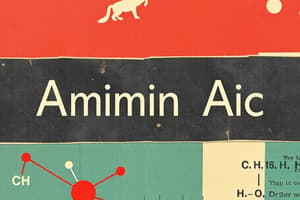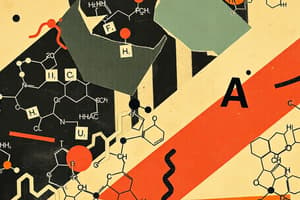Podcast
Questions and Answers
What characteristic distinguishes non-polar compounds from polar ones?
What characteristic distinguishes non-polar compounds from polar ones?
- Non-polar compounds have an ionic bond structure.
- Non-polar compounds have higher boiling points than polar compounds.
- Non-polar compounds have strong hydrogen bonds.
- Non-polar compounds do not dissolve in water. (correct)
Which of the following substances is likely to be classified as non-polar?
Which of the following substances is likely to be classified as non-polar?
- Water
- Ethanol
- Hexane (correct)
- Ammonium chloride
Which property is typically associated with non-polar molecules?
Which property is typically associated with non-polar molecules?
- Formation of strong hydrogen bonds
- High electronegativity differences
- Solubility in polar solvents
- Uniform electron distribution (correct)
Which of the following scenarios best illustrates the behavior of non-polar substances?
Which of the following scenarios best illustrates the behavior of non-polar substances?
Which of these statements is true regarding the molecular structure of non-polar compounds?
Which of these statements is true regarding the molecular structure of non-polar compounds?
Flashcards
Nonpolar molecule
Nonpolar molecule
A molecule with no overall charge, and electrons are distributed evenly.
Polar molecule
Polar molecule
A molecule with a positive and a negative end, due to uneven electron distribution.
Hydrogen bond
Hydrogen bond
A weak attraction between a hydrogen atom of one molecule and a highly electronegative atom (like oxygen or nitrogen) of another molecule.
Covalent bond
Covalent bond
Signup and view all the flashcards
Water molecule
Water molecule
Signup and view all the flashcards
Study Notes
Amino Acid Structures
-
Bases: Arginine (Arg, R), Histidine (His, H), Lysine (Lys, K) are shown with their chemical structures. Arginine and Lysine have positively charged amino groups (+NH3). Histidine has a positively charged amino group and a potentially charged imidazole ring.
-
Aromatic: Tyrosine (Tyr, Y), Phenylalanine (Phe, F), and Tryptophan (Trp, W) are displayed with their chemical structures. These contain aromatic rings.
-
Amides: These structures are not named but are displayed with functional groups.
Nonpolar Amino Acids
- Alkyl: The structures with Alkyl chain are displayed
Other Amino Acids
-
Polar and uncharged: Structures of Isoleucine (Ile, I), Leucine (Leu, L), Proline (Pro, P), with amino acid structures displayed
-
Sulfur-containing: Displayed in structure with cysteine (Cys, C). Structures for methionine (Met, M).
-
Alcohols: Displayed structures for Serine (Ser, S)
-
Acids: Displayed structures for Aspartic Acid (Asp, D), and Glutamic Acid (Glu, E).
-
Chemical formulas and names: Threonine (Thr, T) structures are shown. General amino acid structure is displayed.
Studying That Suits You
Use AI to generate personalized quizzes and flashcards to suit your learning preferences.




